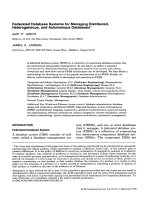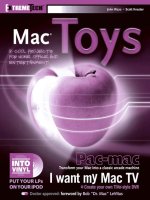Buses, Protocols and Systems for Home and Building Automation
Bạn đang xem bản rút gọn của tài liệu. Xem và tải ngay bản đầy đủ của tài liệu tại đây (4.05 MB, 148 trang )
Buses, Protocols and Systems for
Home and Building Automation
Ondřej N¥¥vlt
Evropsk¥¥ sociln fond. Praha & EU: Investujeme do vaš budoucnosti.
Table of contents
1. Basic categorization......................................................................................................................... 3
1.1. System openness......................................................................................................................... 3
1.2. System centralization .................................................................................................................. 4
1.3. System complexity and versatility............................................................................................... 5
1
Physical layer – communication medium.................................................................................... 6
2
Closed systems ................................................................................................................................ 7
2.1. ABB Ego-N.................................................................................................................................... 7
2.2. Elko EP iNels ................................................................................................................................ 8
1
Eaton/Moeller X-Comfort and Nikobus....................................................................................... 8
2
Open standardized protocols ........................................................................................................ 11
3.1. Complex protocols..................................................................................................................... 12
3.1.1. BacNet ................................................................................................................................... 12
3.1.2. Konnexbus ............................................................................................................................. 14
3.1.3. LonWorks and LonTalk .......................................................................................................... 16
3.2. Specialized and other standardized protocols .......................................................................... 19
3.2.1. DALI ....................................................................................................................................... 19
3.2.2. DMX512................................................................................................................................. 23
3.2.3. EnOcean................................................................................................................................. 28
3.2.4. M-Bus (Meter-Bus)................................................................................................................ 31
1
Evropsk¥¥
sociln fond. Praha & EU: Investujeme do vaš 34
3.2.5. OpenTherm............................................................................................................................
budoucnosti.
SMI (Standard Motor Interface)............................................................................................ 38
2
Other buses and systems used in home automation.................................................................... 42
3
Bibliography................................................................................................................................... 43
Department of Control Engineering
Faculty of Electrical Engineering Czech
Technical University in Prague 2009-2011
1.2.
1. Basic
System
categorization
centralization
Another automation
Building
property which
systems
divides
andprotocols
protocolsand
cansystems
be divided
intointo
veryadifferent
plenty ofgroups
categories
is logical
usingorvery
topology
different
rules. In this wide set of classification properties we can determine some basic and interesting classifiers:
centralization:
openness,
centralization
versatility
of aiNels,
system.
Thesebased
categories
provide
us important information
1
Centralized or
systems
(Ego-n,
systems
on central
PLC)
which
is
crucial
in
assessing
usability
of
a
protocol
or
a
system
for
a
project.
2
Decentralized/distributed systems (KNX, LON, Xcomfort…)
1.1. System openness
This property describes dependency of a system on a manufacturer. There exist two essential categories:
• Open protocols (KNX, LON, BACnet, DALI, OpenTherm, EnOcean…)
• Closed systems (Ego-n, iNels, Nikobus, XComfort) Open protocols are based on open standards or
open specifications, which are accessible for everybody (who pay some fee) – not only for the
manufacturer who developed the protocol. It is common that everything about the protocol is managed by
a special association, not by the developer company. The most significant advantage of this approach is
evident: open specification ensures a big flexibility for the building control system designer because there
usually exist more than one manufacturer of a device with a desired function. Differences between devices
are in a price, design or additional functions. Another advantage is that these protocols are supported by
significant academic research producing new nontraditional features to the system (for example TU Wien is
one of the leading research facilities for the KNX protocol). One of disadvantages of open protocols is
usually the price of the system for family and small houses. These systems are cost-effective for bigger and
large buildings, such as office buildings, hospitals, hotels or airports. Examples of some standards which
cover the most important building automation protocols are KNX -EN 50090 and ISO/IEC 14543, Lon
-ANSI/CEA 709.1, BACnet – ASHRAE/ANSI 135 and ISO 16484-5. Specification (e.g. communication
protocol) of a closed system is, in opposite to open protocols, not public to everyone – it is private to the
developer company. There exist some exceptions – for example Eaton company and their Xcomfort system,
where they offer the specification of their communication protocol in some cases to manufacturers who
can add new features into their system. Closed building automation systems are closer to the end user than
the open protocols – you can buy components (sensors and actors) of these systems in “supermarkets” like
OBI, Hornbach or Baumax. The advantage are the prices of the components and of the whole system for
family houses, flats or small houses. Usually these systems are very easy to install and to “program” (often
without a computer). Closed systems are, in the most of cases, able to solve all the basic task of home
automation. But they do not offer big versatility – a user can choose only from a very small group of
devices and designs. Another problem is that users are dependent on one producer only and when the
manufacturer stops the production of the devices, there will be a problem with the expansion of an
installation and with replacement of crashed devices.
• Hybrid systems (Nikobus) A centralized system (Fig. 1.2.1) has a central unit in the middle of the
system (one or several units) which controls whole system functions. So the system does not need smart
sensors and actors, but is very sensitive to a failure of the central unit. If it fails, then the whole system will
not work. Today, these systems usually use a bus topology, but sometimes they still use direct connections
to sensors and actors (a star topology – every device has its own connection with the central device).
Fig. 1.2.1: Centralized system
Fig. 1.2.2: Distributed system
Hybrid systems (Fig. 1.2.3) are somewhere in between – one example is Nikobus, where inputs (sensors)
are connected using a bus and outputs (actors) are connected direct by using star topology to semi-central
units.
Distributed systems (Fig. 1.2.2) have no central unit. That means that every unit is intelligent/smart and
knows what to do (e.g. when and where to send data). This is of course a big advantage, because the
system is robust and more failsafe/reliable – when one unit fails, then the others work on. Distributed
Fig. 1.2.3: Hybrid
systems always use a bus topology (shared medium).
The system
disadvantage is that the devices are more
expensive than in the case of “dull” devices of a centralized system.
1
Heating, Ventilating, and Air Conditioning
1.3. System complexity and versatility
This parameter represents the ability of a system to cover one or more control tasks in building and home
automation:
1
Complex control system (KNX, LON, Xcomfort, Ego-n) are able to solve every basic task in
1
building automation (for example HVAC , lights, shutters/blinds, visualization or basic security)
2
System and protocols focused on one control task: e.g. DALI bus specialized on light control
or OpenTherm focused on heating control
1.4. Physical layer – communication medium
Standardized complex protocols usually offer more than one physical layer (up to 5 or 6), and commercial
closed building control systems traditionally offer only one. This situation is changing today, because it is
more and more common that a cheap commercial closed system offers, in addition to the communication
by one of wired physical layers, also a wireless communication possibility. Here is a list of some typical
physical layers used in building automation:
1
2
3
4
5
Twisted-pair/RS-485
Powerline 230V
Wireless – infrared, RF, ZigBee…
Ethernet
Coaxial cable
2. Closed systems
Closed building automation systems or proprietary systems are typically focused on family and small
houses. There exit tens of these systems on the market today. They are developed not only by “no name”
producers, but also by traditional companies like ABB or Moeller/Eaton. Components for these systems are
often offered in hobby retail chains like OBI, Hornbach and Baumax, and in most cases they are cheaper
than any system based on an open standard. Closed systems are usually complex, so they can solve all the
basic tasks of home automation
– HVAC, light and shutter/blinds control, remote control (PC, PDA, phone) and so on. A disadvantage is that
they offer only very limited possibilities in functions, interconnections or designs of devices. An advantage
of this kind of systems is that they often do not need any special training for installation and programming
(often without PC, only using a screwdriver). We can find centralized, distributed and also hybrid closed
systems. Closed systems are based on a proprietary communication protocol with wired (Nikobus) or
wireless connection (Xcomfort, Conrad FS20 and HomeMatic). Wireless closed systems are becoming very
popular today because their price is comparable to the price of a wired solution with the advantage of
easier installation (especially for older houses). Also more and more producers start to offer systems with
both types of communication – wired and wireless (iNels).
2.1. ABB Ego-N
Fig. 2.1.2: Ego-n Bus structure – translated and redrawn from (1)
Ego-n can solve typical simple home automation tasks: HVAC, shutter/blinds and light control, motion
detection, simulation of a presence of persons in the house, control over GSM, PC or PDA, fire and security
alarms and so on. The configuration of the system can be done using a computer or by so-called “button
mode” without a PC.
2.2. Elko EP iNels
Fig. 2.1.1: ABB Ego-n (1)
Ego-n (2) is a centralized bus building automation system focused mainly on family houses. It has its origins
in the Czech Republic. The bus is physically realized by a 4-core cable with 2 cores for data and 2 cores for a
power supply to the devices. There exist two types of buses (Fig. 2.1.2): primary (max 700m length) and
secondary (max 2000m length). The primary bus connects sensors and actors (up to 64 devices on the bus)
with a central control unit. The secondary bus is optional and it connects up to 8 central control units, a
GSM unit, a unit of logic functions, a TCP/IP module and other high-end devices.
Fig. 2.2.1: iNels (3)
iNels is a typical fully centralized automation system based on the special central PLC-like unit CU2-01M or
on the modular PLC Tecomat Foxtrot. This system is not focused only on family houses, but with a usage of
the PLC Foxtrot also on BMS (building management systems) of large buildings. In the case of installation
with CU2-01M (up to 192 connected I/O devices) in family houses, the system is capable to solve every
typical task (e.g. HVAC, lights, shutters/blinds) plus some specialties, such as security and fire safety
features, energy management, voice control, control over TV, PC or GSM. If PLC Foxtrot is used as the
control unit, then the possibilities of the system are much wider (up to 288 connected I/O devices using 9
CIB) and of course much more expensive. iNels offers communication over its own bus called CIB (or over
CAN). A new feature is a wireless connection of sensors and actors using protocol RFox. In the case of the
PLC Foxtrot used as the central unit it is possible to communicate over protocols LON, BACnet, DALI, M-Bus,
Profibus DP or Modbus.
2.3. Eaton/Moeller X-Comfort and Nikobus
Evropsk¥¥ sociln fond. Praha & EU: Investujeme do vaš budoucnosti.
functional units (star topology) – Fig. 2.3.2. “Nikobus bus” is physically realized by a twistedpair and is used
also as a power supply for sensors. Nikobus can take care of basic automation tasks, for example: light,
HVAC and shutter/blinds control, switching of electric devices, security and alarms or energy management.
Central functional units are not universal – these devices are specialized on some kind of tasks: a
shutter/blinds unit, a dimming unit or a switching unit. These units have functions prepared inside, so users
have to only configure them (by the computer or using the screwdriver). It is possible to incorporate RF
components into the Nikobus system. Today the Nikobus is a little bit oldfashioned and not much adaptive
system, but can be cost-effective for some basic, simple installations.
Fig. 2.3.3: Nikobus topology – translated from (5)
Fig. 2.3.1: Nikobus
Nikobus (4) is one of a few hybrid building automation systems (in topology). Inputs (up to 256 sensors per
one unit) are connected using a bus with central functional units (actor units), and end-devices like
shutters/blinds, lights or heaters are connected directly to
Fig. 2.3.4: X-Comfort
Xcomfort (6) is an example of relatively cheap complex wireless solution for home automation (especially
suitable for building reconstruction). The system is made of fully decentralized units communicating
together using a proprietary wireless protocol (with a carrier frequency 868.3 MHz). Both actors and
sensors (usually using batteries) are able to route packets, so if one device sends a message for a device
which is not in the range of the
transmitter, then other units in range are able to receive the message and send it to the next device until it
reaches the desired device. The disadvantage is that the routing vector has to be preprogrammed to the
devices (using the computer). Basic configuration of a simple installation (parameterization of predefined
functions) can be done without the computer only by a screwdriver. This system is, as usual, capable to
solve all the typical tasks of home automation, including basic remote visualization of the house on the
computer/PDA or GSM control ability. The advantage of this product is that the producer (
Moeller/Eaton
) of the system offers other companies to share the communication protocol with them if they add some
new interesting feature or device into the
Xcomfort
system. There are of course some disadvantages
–
for example the radiator valve needs external power supply (modern wireless valves use batteries
–
for example in the system made by
Conrad
).









